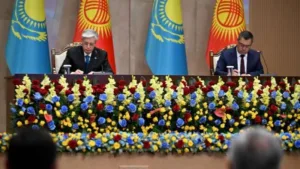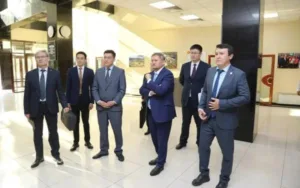One of the most serious environmental threats to human health is air pollution. In Central Asian countries, the concentration of PM2.5 in the air regularly exceeds the permissible limits. This report by a Kazinform News Agency correspondent covers how the region is addressing this issue.

Decarbonization and greening of cities in Kazakhstan
In Kazakhstan, the actual volume of pollutant emissions for 2023 amounted to 2.5 million tons. By industry sector, the breakdown is as follows: 37% from the energy sector, 30% from the mining and metallurgy sector, 20% from oil extraction, and 13% from other sectors. The main sources of air pollution in urban areas are heating sources such as thermal power stations, boilers, industry, outdated sewage treatment facilities, road transport, and the private sector.
According to the Ministry of Ecology and Natural Resources of Kazakhstan, to reduce emissions from industrial facilities, a Plan of Action has been approved to cut emissions by 20% for the 50 largest industrial enterprises.
Since January 2021, Kazakhstan has implemented a new Environmental Code, which is based on the principle “the polluter pays and corrects.” Changes under the code include the introduction of integrated environmental permits for large Category I facilities and the implementation of best available technologies (BAT). Companies that switch to BAT are exempt from emissions fees, while other enterprises will see their emissions fees gradually increase—by 2, 4, and 8 times every three years starting in 2028 (2025 for the top 50 largest enterprises).
In accordance with Article 186 of the Environmental Code, as of January 1, 2023, large industrial enterprises are required to install monitoring systems to track pollutant emissions in real-time and send the data to the National Data Bank on the State of the Environment and Natural Resources. By the end of 2024, approximately 60% of enterprises had installed such systems, transmitting data on pollutant concentrations every 20 minutes. Another 20% of enterprises are in the process of connecting to the system.
In February 2023, the President of Kazakhstan approved the Strategy for Achieving Carbon Neutrality by 2060. Its goal is to reduce greenhouse gas emissions by 15% by 2030 compared to the 1990 emission levels, and by 25% if international support for decarbonizing the economy is received.
To reduce pollutant emissions into the atmosphere, Kazakhstan is actively developing renewable energy sources. The country currently operates 148 renewable energy facilities with a total installed capacity of 2,903.7 MW. These facilities play a key role in reducing the carbon footprint and providing the country’s energy system with clean and sustainable energy.
An important aspect of the environmental strategy is the greening of cities and the creation of “green belts” around industrial areas, which helps with natural air filtration. It is also worth noting that, at the initiative of President Kassym-Jomart Tokayev, the nationwide environmental campaign “Taza Kazakhstan” was launched in April 2024. This campaign aims to improve the country’s environmental situation, raise public awareness of environmental issues, and engage citizens in protecting the environment. By the end of the year, 1.6 million trees were planted as part of the campaign, more than 1.1 million tons of waste were collected, numerous unauthorized landfills were cleared, and mass environmental actions reached 6.2 million people in Kazakhstan.
Gasification and eco-friendly transport in Kyrgyzstan
In Kyrgyzstan, according to a UNICEF study, the annual average exposure to PM2.5 particles for the population across all household types was approximately 3.6 times higher than the levels that adversely affect public health. Preliminary estimates suggest that from 2021 to 2022, this exposure led to 112 deaths, and the estimated economic damage amounted to 2 billion soms (around $24.9 million).
To improve the environmental situation, the government is implementing a range of measures. One of the key areas is the modernization of the energy sector. The World Bank has provided concessional funding to restore and improve the operational efficiency of the country’s energy sector.
Efforts are being made to transition to cleaner fuels, such as natural gas, and to introduce renewable energy sources. A significant measure to improve air quality is the gasification of residential buildings that were previously heated by coal. According to Gazprom Kyrgyzstan, the country’s gasification level reached 40% in the first half of 2024. According to Nursultan Tashybek uulu, head of the Atmospheric Air Department at the Ministry of Natural Resources of Kyrgyzstan, the gasification of settlements has reduced coal consumption by an average of 58,000 tons. To connect to the gas distribution networks, a subsidized loan program is available. The government will allocate 1 billion soms (about $11.5 million) annually for the implementation of this program.
In Bishkek, to improve the environmental situation, more than 1,000 gas-powered buses were purchased in 2024. Each bus replaced four diesel minibuses, and the use of diesel fuel was reduced to 200 tons per day.
In April 2024, a law was adopted to stimulate the use of electric vehicles in the country. The legislative amendments provide for benefits when using electric vehicles, the issuance of special green registration plates for them, and the creation of charging infrastructure for electric cars.
Air pollution rating and ban on fuel oil in Uzbekistan
The increasing level of air pollution in major cities of Uzbekistan, including the capital, is linked to rising emissions from electricity and heat sources, as well as from vehicles running on low-quality fuel, construction activities without master plans, and illegal deforestation. The annual average concentration of PM2.5 in Tashkent exceeds the World Health Organization’s recommended annual level of 5 µg/m³ by more than six times.
To address this issue, plans include the creation of “green belts” around construction material, energy, and metallurgy enterprises, covering 5 hectares and the planting of 10 million trees. From 2025 to 2030, 3,000 hectares of “green belts” and 200 hectares of parks will be developed in Tashkent and its neighboring districts.
Since April 1, 2024, a regional air, water, and environmental pollution rating system has been introduced. To reduce harmful emissions from road transport, the “Eco-Friendly Transport” system will be gradually implemented starting from March 1, 2025, until 2030. This system will involve issuing environmental stickers (green, yellow, red) to vehicles based on their emission levels.
According to the National Program for combatting dust storms and mitigating their consequences (2024-2030), starting January 1, 2026, air pollution levels and meteorological data will be displayed on special monitors and boards in the capital. Additionally, from January 1, 2025, small air monitoring stations will be installed in 12 districts of the capital.
Starting in 2028, Uzbekistan will gradually limit the use and sale of motor fuel (AI-80 gasoline) that does not meet the “Euro-4” environmental standard. The use of fuel oil as a fuel source will be banned for thermal and electric power plants located in Tashkent and surrounding areas by 2030. Furthermore, to reduce the environmental impact of coal used in more than 1,200 greenhouses near the capital, dust-collecting and gas-cleaning equipment will be installed, and greenhouse farms will receive subsidies for such installations.
Measures have also been outlined for transitioning public transport in Tashkent to electricity and gas, as well as increasing the number of subway trains. In 2023, Tashkent purchased 300 electric buses and 700 buses powered by liquefied gas from China, with plans to acquire an additional 350 electric buses for Samarkand. Over the past two years, 3,148.2 km of railway lines have been electrified, and diesel locomotives have been replaced with electric ones. Since January 2022, the import of gasoline and diesel vehicles that do not meet the “Euro-4” environmental standards has been banned. Additionally, a system has been established to encourage citizens to switch to electric vehicles by exempting electric car imports from customs duties, excise taxes, and transport fees. Only a 12% VAT on the total customs value needs to be paid.
Uzbekistan has set a goal to increase the share of renewable energy sources in total electricity production to 40%, which will save 25 billion cubic meters of natural gas annually and reduce harmful emissions by 34 million tons. In December 2023, five solar power plants and one wind power plant were launched and connected to the grid across six regions of Uzbekistan. For individuals installing solar panels, there are exemptions from land and property taxes for three years, and for businesses, the exemption period is 10 years.
Forest restoration and renewable energy development in Tajikistan
According to the World Bank, the annual average concentration of PM2.5, weighted by population in Tajikistan, was 35.93 µg/m³, the highest among Central Asian countries. This level exceeds the EU’s limit (25 µg/m³) and is significantly higher than the WHO’s target (5 µg/m³).
The country has registered 4,800 deaths due to air pollution from PM2.5 particles, primarily from ischemic heart disease (51%) and stroke (27%). Another major air pollutant affecting health is ozone, which accounts for 60 to 230 deaths. The corresponding healthcare costs are estimated at 4% of GDP. Other consequences of air pollution include crop losses and accelerated glacier melt.
One of the key measures by the authorities to address air pollution is the shift to cleaner fuels in the energy and transport sectors. Importing electric vehicles has been exempted from customs duties, and there is a ban on the use of vehicles manufactured before 2013.
One of the adaptation measures to reduce the impact of dust storms in Tajikistan is forest restoration. The country has developed a Forest Sector Development Strategy for 2016-2030.
To prevent dust and haze, with the support of the Tajik and South Korean governments, the largest saxual plantation in the south of the country was established, covering more than 300 hectares. Over 250,000 saxual saplings are being grown in the Aivaj Shahritus nursery for future planting in the desert area of the region. Saxual trees protect the sandy soil from wind, trap sand, and help prevent wind erosion.
Experts point out that Central Asian countries cannot address air pollution solely within their own territories. This issue does not recognize national borders: emissions from a source in one country can be transported and deposited in a neighboring country. Establishing cooperation between countries and developing a common agenda is crucial.
According to experts, air quality management in Central Asian countries is a serious issue that requires joint, comprehensive efforts at the local, national, and regional levels, involving various stakeholders and international partners.
According to the “Global Burden of Disease 2019” study, the global health damage caused by air pollution is estimated at $8.1 trillion, equivalent to 6.1% of global GDP.
Earlier, Kazinform News Agency reported that President of Uzbekistan received heads of parliamentary delegations from Central Asian countries.




